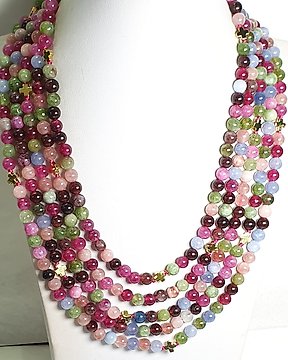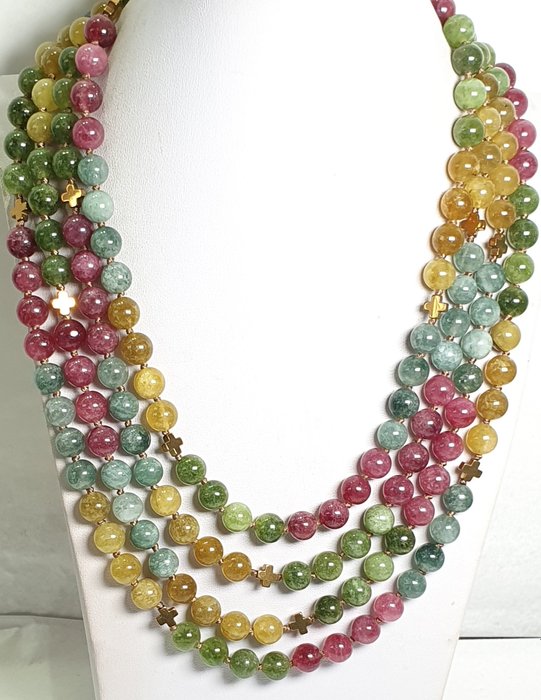
Akvamarin, peridot, rosenkvarts, granat, pink turmalin, karneol... belagt 925 sølvbroche - Halskæde
Nr. 82889713

Nr. 82889713

I offer for auction a spectacular very long necklace of gold plated hematite Greek crosses (protection & balance) and mixed gems (olivine, garnet, pink tourmaline, carnelian, green agate ...). The entire necklace has been spun by hand with knots on each bead and cross; the clasp is made of gold plated 925 silver.
This exclusive necklace, being very long, can be worn in many different ways, all very flattering depending on the occasion.
Material: (olivine, garnet, pink tourmaline, carnelian, green agate ...)
Size: 8/7 mm
Greek crosses made of gold plated hematite
Necklace length: 194 cm - very long!!!
Gold plated 925 silver clasp - marked "925" - large & solid
Necklace spun by hand with knots on each bead and cross (see photos)
Gift Box and protective bag
Greek cross (crux quadrata): An old type of cross with arms of equal length.
It is the most absolute simplification of the symbol. It is the concentration in its pure state.
The meaning of the Greek Cross is that of protection and balance, due to its symmetrical shape with arms of the same size. It is also believed that the Greek cross is a representation of God and on the other hand the Latin cross that we all know is the representation of the crucifixion of Christ.
The Greek Cross despite the fact that its name indicates that it was born and used mainly in Greece, it is not. The Greek Cross makes its appearance in the East by the Christians who inhabited those territories. The cross was based on the Immisa Cross where Jesus died but with the stick shortened, giving it a symmetrical aesthetic to be able to see it in the same way from any direction.
It is believed that the use of this cross in the East was influenced by the True Cross found in Jerusalem. Helena of Constantinople, also known as Saint Helena, dedicated her life to finding the relics of the True Cross (the cross where Jesus Christ was crucified). She traveled to Jerusalem in about 326 to discover its location.
She finally said to find the place where the true cross and the tomb of Jesus was located. Then her son Constantine built a church at the request of her mother in the same place where there was already an ancient temple erected to Venus (for the Romans) or Aphrodite (for the Greeks). This church was known as the Church of the Holy Sepulchre, located in the area of the old city of Jerusalem.
After finding the cross where Jesus Christ died, Saint Helena cut off the lower part of the Cross (approximately a fifth of its height) and sent it to Rome as a relic, known as the Lignum Crucis. She then left the remaining cross in Jerusalem, which, having been sawn, was left in the shape of a Greek Cross.
Photos are part of the description
Sådan køber du hos Catawiki
1. Opdag noget særligt
2. Afgiv det højeste bud
3. Foretag en sikker betaling